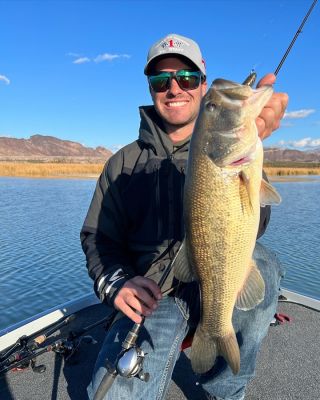The change from fall to winter can be some of the year's best fishing as the temperatures begin to cool, but it can also create unique fishing situations. In July, California pro Jordon Collom wrapped up his first season on the MLF Tackle Warehouse Invitationals. He's now spending time fishing SoCal and the desert lakes on the Colorado River lakes like he does every fall and winter.
He shared some of the unique conditions he's encountered and how he's found a way to get bites.
A fading topwater bite
Fishing a topwater can be a great way to catch bass when fall is in full swing, but sometimes the bass don't commit all the way. In these instances, Collom found a way to still capitalize on the bite with a soft plastic like a Deps Cover Scat.
"There are times when the fish are pressured, or they don't want to commit to a topwater and will just come up and swipe at your bait," he said. "I'll fish a Cover Scat like an underwater topwater and walk the dog right under the surface to get these fish to bite. It's great for getting those fish that won't break the surface to get your standard topwaters and the Scat comes in some great shad patterns to match what they are eating."
Collom fishes it on a 5/O extra-wide gap hook and has succeeded in several popular fisheries. "I've done it on Mead, Mohave, and Havasu and caught them," he said. "The main key is you want clear water because they can see it from a long way and will come to get it."
Suspended bait chasers
As the water cools, shad group up and become bait balls and the bass are usually right there to eat. With forward-facing sonar, you can see it all happen right on your screen. This generally occurs in open water and targeting these suspended bass can be tricky, but Collom reaches for a jighead with a 4-inch Deps Sakamata Shad.
"I fish is 'Damiki Rig' style and it's not just a vertical technique; I like to cast it out and fish through the bait balls," he said. "Forward-facing sonar has unlocked the whole thing and you can see the bait and the dots corralling the bait below them. I fish it between 10 and 60 feet of water most of the time, but it works anytime you see baitfish on your screen."
Burning the bank
Collom says that he's a power fisherman at his core and will always seek out a cranking bite this time of year. Shallow crankbaits are his go-to, especially if it's windy.
"There is usually a good cranking bite early and late in the day, and I'm a bank burner at heart, so always try to get on that bite," he said. "The ima shaker is a great cold water crankbait because it puts off a ton of vibration and as the water cools off, it gets big bites. I also like the ima Pinjack, which comes through grass well because it has a longer bill. It even comes through the spiny naiad, that hard grass they have at Havasu."
Two jerkbait bites
All jerkbaits are not the same and there are times when one will outperform the other because of how they act. Collom knows this and uses several baits, including the ima Flit and Deps Balisong Minnow. While they look similar, they have very different sounds and actions.
"A jerkbait is always good during the winter and always catches them, especially if you get a little warmer weather late in the day," he said. "On the desert lakes, those fish will show themselves and follow a bait 20 feet and you can mesmerize them and get them to bite by changing your retrieve and watching your forward-facing sonar."
Collom prefers the ima Flit 120 when the fish are more aggressive and opts for the Balisong Minnow 100 when he needs something more subtle.
"The Flit is what I fish when I see a lot of bass and baitfish activity because it has great action at fast speeds and it's really loud. It has the BBs in it that makes it sound like a lipless crankbait and can call them in," he said. "The Balisong looks super realistic, and I like to fish it with long pauses."
Fishing is all about adapting to the conditions and tricking the fish into biting. There are many ways to show them something a little different and anglers like Collom have different little ways to get them to bite during the fall-to-winter transition.






 Advertising
Advertising